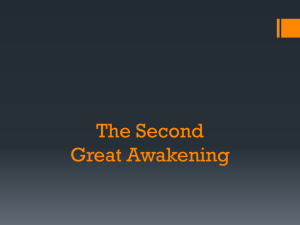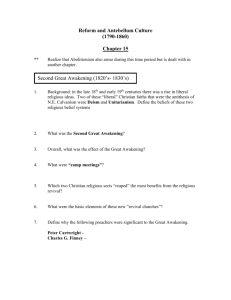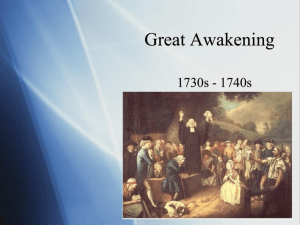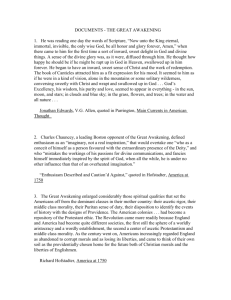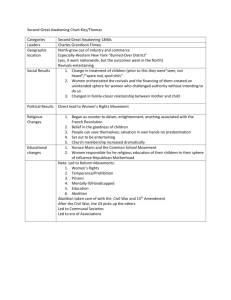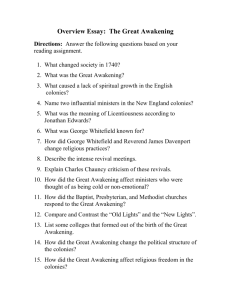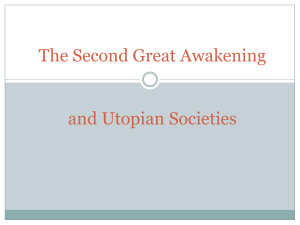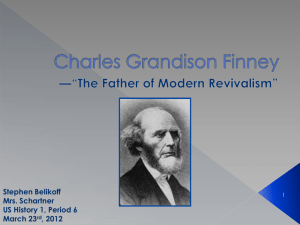The Second Great Awakening
advertisement
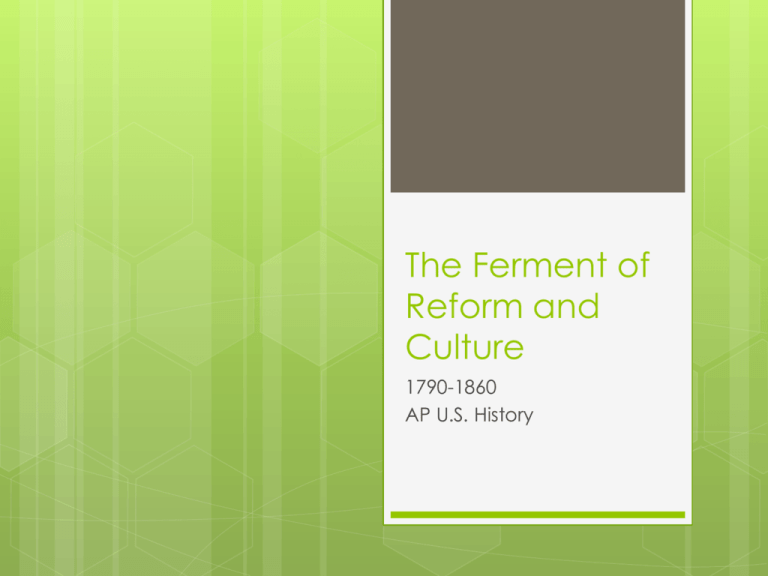
The Ferment of Reform and Culture 1790-1860 AP U.S. History Essential Question How was the Second Great Awakening a reflection of the changing American society? Reviving Religion The ideas from the Age of Enlightenment, such as logic, scientific reasoning, and philosophy, began to erode the public’s beliefs in old church orthodoxy. Even the Founding Fathers, like Jefferson and Franklin, embraced liberal ideas. Maybe Jesus is not the son of God. Churches are set up to enslave mankind. Maybe God isn’t who we think he is. Paine Franklin Jefferson Deists, while believing in a Supreme Being, believed in reason rather than faith; on science rather than the Bible. Deism inspired the Unitarian faith. Unitarians did not believe in the Holy Trinity (Jesus was not God), stressed the goodness in people (unlike the Calvinists), and believed in salvation through good works. Reviving Religion The tendency toward rationalism and indifference in religion was reversed about 1800 by the revivalist movement called the Second Great Awakening. The Second Great Awakening was spread to the masses on the Western frontier by large “camp meetings.” How does this painting symbolize the changes in American society, as reflected in religious camp meetings out West? Religious Camp Meeting by J. Maze Burbank, 1839 Reviving Religion Two denominations that especially gained adherents among the common people of the West and South were Methodists and Baptists. The Second Great Awakening derived its religious strength especially from the popular preachings of evangelical revivalists in both the West and eastern cities. Dude, Joseph – you practiced polygamy. What did you expect? My people fled to Utah territory because we were persecuted for our actions. You are not predestined for heaven or hell. Joseph Smith, founder of the Mormon faith, began his church in the BurnedOver District. Charles Grandison Finney Peter Cartwright, Methodist preacher Western New York had so many intense camp revivals that it was called the “Burned-Over District Reviving Religion Evangelical preachers like Charles Grandison Finney linked personal religious conversion to the Christian reform of social problems. Abolition and temperance! Charles Grandison Finney Tax-supported public education! Horace Mann Better treatment of the mentally ill. Dorothea Dix Women’s suffrage! Susan B. Anthony A key feature of the Second Great Awakening was the number of middleclass women (the wives and daughters of businessmen) who stayed true to church doctrine and turned to saving the rest of society after helping bring their families back to God. Denominational Diversity The major effect of the growing slavery controversy on the churches was the split of Baptists, Methodists, and Presbyterians into separate northern and southern churches. The wealthier and better educated people of New England were less influenced by the religious revivals. The less educated Methodists, Baptists, and other new sects of the Western and Southern frontiers were really caught-up in the religious fervor. Is this a reflection of class conflict or sectionalism? First the churches split. Charles Grandison Finney And eventually the Union split. Peter Cartwright, Methodist preacher Women in Revolt One cause of women’s subordination in nineteenth-century America was the sharp division of labor that separated women at home from men in the workplace. The Seneca Falls Convention launched the modern Women’s Rights Movement with it call for equal rights, including the right to vote. Equality in the workplace! Everyone used to work at home. Now, men go to work in a business or factory, but what should women do? Equality in the courts! Lyman Beecher Susan B. Anthony Elizabeth Cady Stanton Wilderness Utopias Continuing with the utopian spirit of the times, many of the American reformers of the early nineteenth century focused on communal economics and alternative sexual arrangements. We share everything – and I mean EVERYTHING John Humphrey Noyes Freaks. The Oneida Community saw perfect Christianity as abandoning selfishness, which included owning no property and sharing sexual partners. Charles Grandison Finney Glowing Literary Lights A blossoming of American literature accompanied the reform movements of the Second Great Awakening. Leading female imaginative writers who added to New England’s literary prominence were Louisa May Alcott and Emily Dickinson. Hey. What’s up?. The Knickerbocker Group of American writers included Washington Irving, James Fenimore Cooper, and William Cullen Bryant. You ever hear of The Legend of Sleepy Hollow? Yeah, that’s me. Thanatopsis is an awesome poem. James Fenimore Cooper Louisa May Alcott Emily Dickinson Last of the Mohicans is one of mine. Washington Irving William Cullen Bryant Trumpeters of Transcendentalism Part of the liberalizing movement from the age of reason was transcendentalism, which stressed the ideas of inner truth and individual self-reliance. This is the type of idea the Second Great Awakening sought to stamp out. It’s not what you look at that matters, it’s what you see. Nobody can bring you peace but yourself Truth is found in the Bible. Come to a camp meeting for goodness sake! Charles Grandison Finney Henry David Thoreau Ralph Waldo Emerson Questions to Consider 1. 2. 3. How did a growing middle class shape the reform movements of the Second Great Awakening? What were the motives of those participating in the Second Great Awakening, especially women? How does the Second Great Awakening reflect changes in American society?
